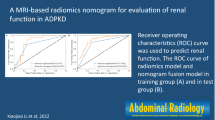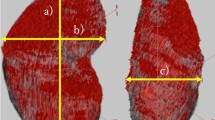Abstract
Objective
Although the guideline indicates that total kidney volume (TKV) is an important detection indicator in patients with autosomal dominant polycystic kidney disease (ADPKD), this study attempted to demonstrate that renal parenchymal information, combined with parenchymal volume and radiomics features, may have more valuable clinical guiding significance.
Methods
A totals of 340 ADPKD patients with normal renal function were prospectively collected and followed-up for five years, with renal function tests and non-contrast computed tomography (CT) performed every six months. The relationship between renal function impairment and renal parenchymal volume (RPV) as along with radiomics features was explored using a multiple linear regression model and multiple logistic regression. Then, a combined model of RPV with radiomics features was constructed to comprehensively evaluate its predictive value.
Results
Compared with TKV, decreased RPV presented a closer relationship with renal function impairment, namely, with the impairment rate (RPV: 82.3% vs. TVK: 67.1%) and eGFR (RPV: r = 0.614, p < 0.001 vs. TKV: r = -0.452, p < 0.001), and showed higher predictive power (RPV: AUC = 0.752 [95%CI 0.692–0.805], p < 0.001 vs. TKV: AUC = 0.711 [95%CI 0.649–0.768], p < 0.001). Correspondingly, the radiomics analysis that was derived from the renal parenchyma also showed a satisfactory result (AUC = 0.849 [95%Cl 0.797–0.892], p < 0.001). Importantly, the predictive power for renal function impairment was further improved in the combined model of RPV and radiomics features (AUC = 0.902 [95%Cl 0.857–0.937], p < 0.001).
Conclusion
Renal parenchyma information may be a sensitive biomarker of renal function impairment in ADPKD, which can provide a new approach for clinically monitoring renal function, and may greatly improve the pre-hospital prevention and treatment effects.
Graphical abstract







Similar content being viewed by others
Abbreviations
- ADPKD:
-
Autosomal dominant polycystic kidney disease
- TKV:
-
Total kidney volume
- CT:
-
Computed tomography
- RPV:
-
Renal parenchymal volume
- GFR:
-
Glomerular filtration rate
- Scr:
-
Serum creatinine
- VOI:
-
Volume of interest
- IG:
-
Impairment group
- NIG:
-
Non-impairment group
- ICCs:
-
Intraclass correlation coefficients
- ROC:
-
Receiver operating characteristic
- AUC:
-
Area under the curve
- AI:
-
Artificial intelligence
- DL:
-
Deep learning
- TA:
-
Texture analysis
References
Cornec-Le Gall E, Alam A, Perrone RD: Autosomal dominant polycystic kidney disease. Lancet 393:919-935, 2019. https://doi.org/10.1016/S0140-6736(18)32782-X
Ghata J, Cowley BD Jr: Polycystic Kidney Disease. Compr Physiol 7:945-975, 2017. https://doi.org/10.1002/cphy.c160018
Chebib FT, Torres VE: Recent Advances in the Management of Autosomal Dominant Polycystic Kidney Disease. Clin J Am Soc Nephrol 13:1765-1776, 2018. https://doi.org/10.2215/CJN.03960318
Vart P, Grams ME: Measuring and Assessing Kidney Function. Semin Nephrol 36:262-272, 2016. https://doi.org/10.1016/j.semnephrol.2016.05.003
Schrier RW, Brosnahan G, Cadnapaphornchai MA, Chonchol M, Friend K, Gitomer B, Rossetti S: Predictors of autosomal dominant polycystic kidney disease progression. J Am Soc Nephrol 25:2399-2418, 2014. https://doi.org/10.1681/ASN.2013111184
Tangri N, Hougen I, Alam A, Perrone R, McFarlane P, Pei Y: Total Kidney Volume as a Biomarker of Disease Progression in Autosomal Dominant Polycystic Kidney Disease. Can J Kidney Health Dis 4:1-6, 2017. https://doi.org/10.1177/2054358117693355
Perrone RD, Mouksassi MS, Romero K, Czerwiec FS, Chapman AB, Gitomer BY, Torres VE, Miskulin DC, Broadbent S, Marier JF: Total Kidney Volume Is Prognostic Biomarker of Renal Function Decline and Progression to End-Stage Renal Disease in Patients with Autosomal Dominant Polycystic Kidney Disease. Kidney Int Rep 2:442-450, 2017. https://doi.org/10.1016/j.ekir.2017.01.003
Chapman AB et al.: Kidney volume and functional outcomes in autosomal dominant polycystic kidney disease. Clin J Am Soc Nephrol 7:479-486, 2012. https://doi.org/10.2215/CJN.09500911
Xue C, Zhou C, Mei C: Total kidney volume: the most valuable predictor of autosomal dominant polycystic kidney disease progression. Kidney Int 93:540-542, 2018. https://doi.org/10.1016/j.kint.2017.10.027
Jo WR, Kim SH, Kim KW, Suh CH, Kim JK, Kim H, Lee JG, Oh WY, Choi SE, Pyo J: Correlations between renal function and the total kidney volume measured on imaging for autosomal dominant polycystic kidney disease: A systematic review and meta-analysis. Eur J Radiol 95:56-65, 2017. https://doi.org/10.1016/j.ejrad.2017.07.023
Grantham JJ, Mulamalla S, Swenson-Fields KI: Why kidneys fail in autosomal dominant polycystic kidney disease. Nat Rev Nephrol 7:556-566, 2011. https://doi.org/10.1038/nrneph.2011.109
Turco D, Valinoti M, Martin EM, Tagliaferri C, Scolari F, Corsi C: Fully Automated Segmentation of Polycystic Kidneys From Noncontrast Computed Tomography: A Feasibility Study and Preliminary Results. Acad Radiol 25:850-855, 2018. https://doi.org/10.1016/j.acra.2017.11.015
Mayerhoefer ME, Materka A, Langs G, Häggström I, Szczypiński P, Gibbs P, Cook G: Introduction to Radiomics. J Nucl Med 61:488-495, 2020. https://doi.org/10.2967/jnumed.118.222893
Xu X, Zhang HL, Liu QP, Sun SW, Zhang J, Zhu FP, Yang G, Yan X, Zhang YD, Liu XS: Radiomic analysis of contrast-enhanced CT predicts microvascular invasion and outcome in hepatocellular carcinoma. J Hepatol 70:1133-1144, 2019. https://doi.org/10.1016/j.jhep.2019.02.023
van Griethuysen J, Fedorov A, Parmar C, Hosny A, Aucoin N, Narayan V, Beets-Tan R, Fillion-Robin JC, Pieper S, Aerts H: Computational Radiomics System to Decode the Radiographic Phenotype. Cancer Res 77:e104-e107, 2017. https://doi.org/10.1158/0008-5472.CAN-17-0339
Khan JN, Singh A, Nazir SA, Kanagala P, Gershlick AH, McCann GP: Comparison of cardiovascular magnetic resonance feature tracking and tagging for the assessment of left ventricular systolic strain in acute myocardial. Eur J Radiol 84:840-848, 2015. https://doi.org/10.1016/j.ejrad.2015.02.002
Kursa MB, Rudnicki WR: A Deceiving Charm of Feature Selection: The Microarray Case Study. Berlin, Heidelberg 145–142, 2011.
Kursa M, Rudnicki W: Feature Selection with Boruta Package. J Stat Softw 36:1–13, 2010. https://doi.org/10.18637/jss.v036.i11
Smith KA, Thompson AM, Baron DA, Broadbent ST, Lundstrom GH, Perrone RD: Addressing the Need for Clinical Trial End Points in Autosomal Dominant Polycystic Kidney Disease: A Report From the Polycystic Kidney Disease Outcomes Consortium (PKDOC). Am J Kidney Dis 73:533-541, 2019. https://doi.org/10.1053/j.ajkd.2018.11.001
Brunetti A, Cascarano GD, De Feudis I, Moschetta M, Gesualdo L, Bevilacqua V: Detection and Segmentation of Kidneys from Magnetic Resonance Images in Patients with Autosomal Dominant Polycystic Kidney Disease. Cham: Springer 639–650, 2019.
Zheng Y, Liu D, Georgescu B, Xu D, Comaniciu D: Deep Learning Based Automatic Segmentation of Pathological Kidney in CT: Local Versus Global Image Context. Cham 241–255, 2017.
Sharma K, Rupprecht C, Caroli A, Aparicio MC, Remuzzi A, Baust M, Navab N: Automatic Segmentation of Kidneys using Deep Learning for Total Kidney Volume Quantification in Autosomal Dominant Polycystic Kidney Disease. Sci Rep 7:2049, 2017. https://doi.org/10.1038/s41598-017-01779-0
Kline TL, Korfiatis P, Edwards ME, Blais JD, Czerwiec FS, Harris PC, King BF, Torres VE, Erickson BJ: Performance of an Artificial Multi-observer Deep Neural Network for Fully Automated Segmentation of Polycystic Kidneys. J Digit Imaging 30:442-448, 2017. https://doi.org/10.1007/s10278-017-9978-1
Lambin P et al.: Radiomics: the bridge between medical imaging and personalized medicine. Nature Reviews Clinical Oncology 14:749-762, 2017. https://doi.org/10.1038/nrclinonc.2017.141
Lambin P et al.: Radiomics: extracting more information from medical images using advanced feature analysis. Eur J Cancer 48:441-446, 2012. https://doi.org/10.1016/j.ejca.2011.11.036
Gillies RJ, Kinahan PE, Hricak H: Radiomics: Images Are More than Pictures, They Are Data. Radiology 278:563-577, 2016. https://doi.org/10.1148/radiol.2015151169
Kline TL et al.: Image texture features predict renal function decline in patients with autosomal dominant polycystic kidney disease. Kidney Int 92:1206-1216, 2017. https://doi.org/10.1016/j.kint.2017.03.026
Szczypiński PM, Strzelecki M, Materka A, Klepaczko A: MaZda--a software package for image texture analysis. Comput Methods Programs Biomed 94:66-76, 2009. https://doi.org/10.1016/j.cmpb.2008.08.005
Max K: Building Predictive Models in R Using the caret Package. Journal of Statistical Software 28:1–26, 2008. https://doi.org/10.18637/jss.v028.i05
Zhao Y, Liu G, Sun Q, Zhai G, Wu G, Li ZC: Validation of CT radiomics for prediction of distant metastasis after surgical resection in patients with clear cell renal cell carcinoma: exploring the underlying signaling pathways. Eur Radiol 31:5032-5040, 2021. https://doi.org/10.1007/s00330-020-07590-2
Funding
This work was supported by National Natural Science Foundation of China (81871343); Jiangsu Provincial Key Research and Development Plan (BE2017698, BE2018693); the Natural Science Foundation of Jiangsu Province (BK20181226, BK20171311).
Author information
Authors and Affiliations
Contributions
All authors had full access to all the data in the study and take responsibility for the integrity of the data and the accuracy of the data analysis. Study concept and design: YX, MX, XZ, SJ, YL. Acquisition of data: YX, MX, YC. Analysis, interpretation of data, and drafting of the manuscript: YX, MX, XZ, SJ. Critical revision of the manuscript for important intellectual content: all authors. Obtained funding: YL.
Corresponding authors
Ethics declarations
Conflict of interest
The authors declare no competing interests.
Ethical approval
All procedures performed in studies involving human participants were in accordance with the ethical standards of the institutional and/or national research committee and with the 1964 Helsinki Declaration and its later amendments or comparable ethical standards. The local Institutional Review Board approved this study and written consents were obtained from all participants after they received a complete and detailed description of the study.
Additional information
Publisher's Note
Springer Nature remains neutral with regard to jurisdictional claims in published maps and institutional affiliations.
Supplementary Information
Below is the link to the electronic supplementary material.
Rights and permissions
About this article
Cite this article
Xie, Y., Xu, M., Chen, Y. et al. The predictive value of renal parenchymal information for renal function impairment in patients with ADPKD: a multicenter prospective study. Abdom Radiol 47, 2845–2857 (2022). https://doi.org/10.1007/s00261-022-03554-w
Received:
Revised:
Accepted:
Published:
Issue Date:
DOI: https://doi.org/10.1007/s00261-022-03554-w




